
The information for this cruise came from three sources. The official US Navy Ships History, The Cruise log compiled by shipmates Flook, Suchajda, and Walters and from personal recollections of the men that were on the cruise.

 To review a summary of the sea miles traveled during this cruise that have been extracted from the Cruise book click here
To review a summary of the sea miles traveled during this cruise that have been extracted from the Cruise book click here
The First Cruise - September 1953 to April 1955
Initially attached to Amphibious Forces, AtlanticFleet, LST-1159 conducted shakedown in Guantanamo Bay and the Caribbean before commencing local operations out of Norfolk and Little Creek, Va. | 
Gitmo Naval Base |
She departed Norfolk on 24 February 1954 for duty with Amphibious Forces, Pacific Fleet, and after transit of the Panama Canal, reached the west coast on 20 March.

Panama Canal - The Cut
The Tank Landing Ship operated out of her new home port, San Diego, until 20 September, including calls at San Francisco and San Pedro, California, and Esquimalt, British Columbia in her itinerary.

Training operations with the UDT teams off San Clemete Island was one of the more interesting duties while home ported at San Diego. The high speed pickups and drops were about the only time we could see what the "frogmen" were doing.
Approximately half of the plank owners remained on the ship for the voyage across the Pacitic Ocean. This photo was taken just prior to our departure to the Far East.

Enroute to the Far East, LST 1159 stopped briefly at Pearl Harbor before proceding on toward Japan.
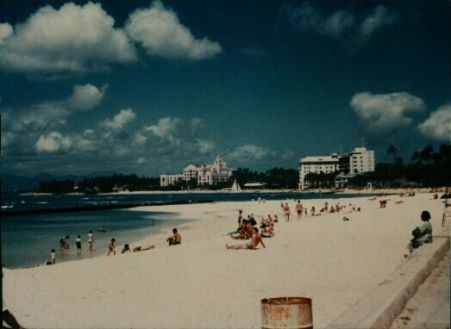
Waikiki Beach in 1954
During 1954 there were only 2 hotels on Waikiki Beach. The Ala Moana is in the foreground and the Royal Haiwaian is in the background. Tucked in the trees between the hotels is the Canoe Club.
![]()
Crew Comment
While crossing the Pacific I was sent a Navy telegram announcing the birth of my first son and informing me that mother and son were doing fine.
Ed Lange
![]()
Passage to Freedom
On Oct 2, 1954 the ship departed Pearl Harbor crossing the International Date line on Oct 7 1954 at 1602 local time at latitude 25 degrees North longitude W 180 degrees E.
While on the voyage across the Pacific, the ship was diverted to join Task Force 98 in Southeast Asian waters and arrived at Henrietta Pass, near the port of Haiphong, French Indo China, on 29 October 1954.
To see a brief sumary of the major events that led to the Seventh Fleet participating in Passage to Freedomclick here
Taking part in operation "Passage to Freedom," LST 1159 transported refugees from the northern part of what became a divided Vietnam, to the southern ports of Tourane(Danang) and Saigon.
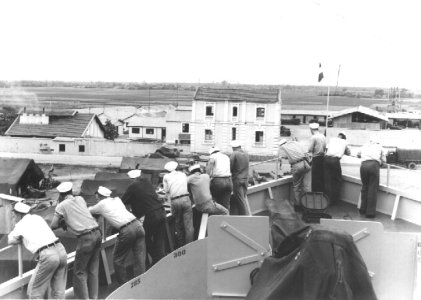
Beached at Haiphong

Loading French Equipment
The driver of the truck lost traction while going up the loading ramp to the main deck. When he backed down the trailer he was towing jack knifed. Muscle power was required to straighten out the rig for the next try.
![]()
Crew Comment
Several problems occurred at this landing. The first was peeling back the bow doors during the beaching and the second was getting a hawser fouled in the screws. A diver had to go down to cut the hawser out of the prop.
![]()
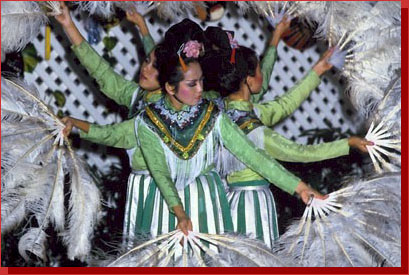
Vietnamese Dancers In Saigon
On 29 November 1954, her job in the massive humanitarian effort completed, the tank landing ship proceeded toward her original destination.
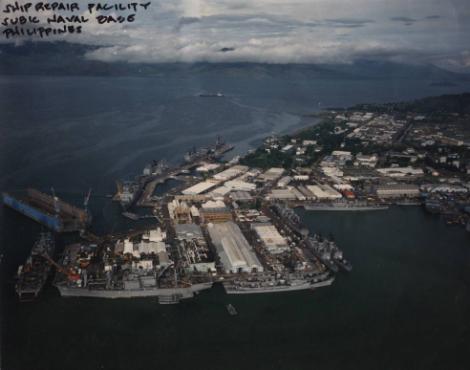
Subic Bay
LST 1159 proceeded via Subic Bay, Philippine Islands, and Hong Kong, British Crown Colony, and arrived at Yokosuka, Japan, on 22 December 1954.

Hong Kong Harbor At Night
Hong Kong Mary
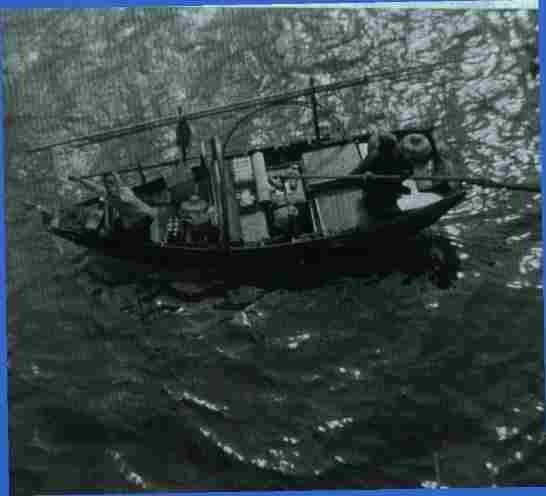 About 5 minutes after the LST 1159 entered Hong Kong Harbor a sampam pulled alongside and a small lady in the bow of the sampam requested permission to come aboard.
About 5 minutes after the LST 1159 entered Hong Kong Harbor a sampam pulled alongside and a small lady in the bow of the sampam requested permission to come aboard.
I was surprised that permission was granted but a few minutes later this small lady was aboard and she and some of the Officers began what proved to be a business negotion. The lady, now identified as Mary Soo, had a portfolio of references from damn near every ship that had ever entered Hong Kong Harbor. All praised the quality of her work.
An agreement was reached. Mary Soo would remove all garbage from the ship. It was believed the garbaage would be picked through and anything good was sold ashore. Also agreed to was that Mary Soo would paint the ship for a small sum of money if all the old cordage aboard would be given to her and if the ship supplied the paint. Members of the deck force chipped in $1 apiece to raise the money required and were glad to do it. Hanging over the side in a Bosuns chair painting the sides is not fun.
Work began the following day. The garbage detail was handled efficiently and not a single mess cook complained. The painting detail was a lesson in organization. Mary Soo brought a few men with her to handle the long poles used for roling on the paint high up on the sides. The rest of the painting was handled by women. Deck apes continually were looking for spots that were missed, but did not find any. Even the waterline looked to be as straight as the ones painted on in dry dock. Not bad for working out of a small boat that never stopped pitching and rolling from the wakes of passing vessels.
 Over the years Mary Soo, better known as Hong Kong Mary to many old timers, became a living legend. Life Magazine ran a full spread article on this amazing little lady that may have been the first fully liberated woman in China.
Over the years Mary Soo, better known as Hong Kong Mary to many old timers, became a living legend. Life Magazine ran a full spread article on this amazing little lady that may have been the first fully liberated woman in China.

Yokosuka
If you would like to read a short ichi ichi story ,click here.
The Tank Landing Ship payed calls on the Japanese ports of Moji, Sasebo, and Kobe before a deteriorating international situation resulted in the ship's call to duty with Task Force 76 at Buckner Bay, Okinawa, on three February 1955.
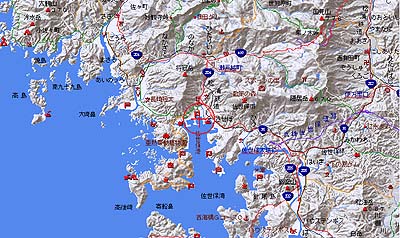
Sasebo
Tachen Island Operation
She sortied from Okinawa soon thereafter and took part in the evacuation of the Tachen Islands from 8 to 13 February, moving 2,144 civilians, 1,100 troops, 600 tons of ammunition, and 37 vehicles to Formosa(Taiwan) in two round trips.
 To review a brief history of the events leading up tho this evacuation and the events that followed CLICK HERE
To review a brief history of the events leading up tho this evacuation and the events that followed CLICK HERE
Communist Chinese shore batteries had continuously shelled the Tachen Islands, inflicting many civilian and Army casualties. The Nationist Chinese goverment decided the cost of holding the islands was too high and began evacuation. An earlier LST that tried to land was shelled by the mainland shore batteries and sunk, as were some other vessels.

Sunken LST In Approach to Landing Site
We experienced a few anxious moments going into the Tachens under General Quarters. Would they shoot at us? The Seventh Fleet being in view offshore, with lots of big guns aimed toward the beach proved to be a successful deterent.

Same Sunken LST With Another
Sunken Vessel In Background

High And Dry

LCUs, M-Boats, LCVPs and soldiers loading ammo on our LST
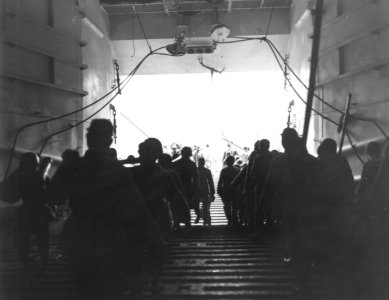
Chinese Soldiers
Loading Munitions
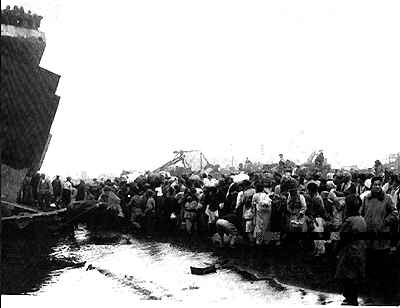
Refugees Coming Aboard
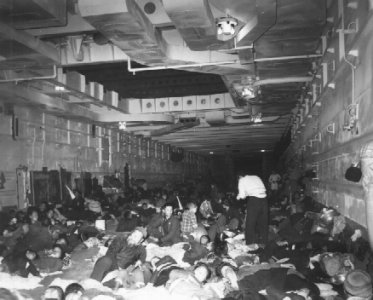
First Load of Refugees
Going To Tourane
A mountain of refugee duffel was stowed on the after tank deck and one of the refugee children was playing on the "mountain" while the ship was underway. The load shifted in the sea swell and the child was killed. The child was buried at sea. I believe this was the only burial at sea on the Tom Green County.

Approaching the Rail

Officers and Side
Boys Formed Up
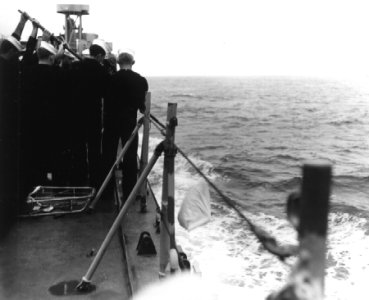
Commited To
The Deep
This was a sad and somber moment. The accidental death of an innocent child. The burial at sea. The parents and leaders obvious sorrow.
When this operation was completed LST returned to Sasebo, Japan and then continued on to Inchon,Korea.
![]()
Hello there: Just to let you know that I think my dad(maybe a 12-year-old) and his entire familly was on board during the evacuation. My grandfather was one of the county officers.
My grandparents are past away, my dad is retired, now my elder brother and his wife lives in Long Island, NY. I'll show the photos to my dad and see if he remembers anything.
It's incredible that one can find the piece of evidence of history via internet surfing, no matter how shabby and sad the history was.
Thanks and regards
Pei Han Wang
![]()
Returning to the United States, Tom Green County made port at San Diego on 2 April 1955 to begin a period of local operations out of that port.

The Best Part Of A Cruise
 people have visited this page
people have visited this page

![]() *Go to The Next Cruise*
*Go to The Next Cruise*
![]() *Return to Table of Contents*
*Return to Table of Contents*



![]()
